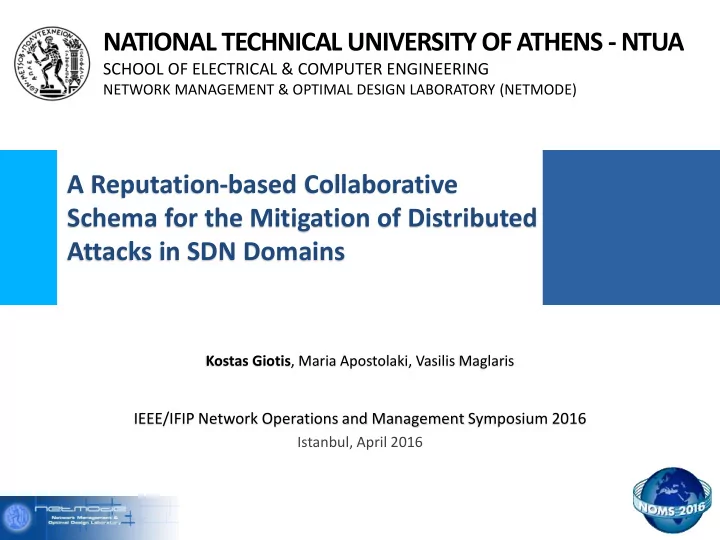

NATIONAL TECHNICAL UNIVERSITY OF ATHENS - NTUA SCHOOL OF ELECTRICAL & COMPUTER ENGINEERING NETWORK MANAGEMENT & OPTIMAL DESIGN LABORATORY (NETMODE) A Reputation-based Collaborative Schema for the Mitigation of Distributed Attacks in SDN Domains Kostas Giotis , Maria Apostolaki, Vasilis Maglaris IEEE/IFIP Network Operations and Management Symposium 2016 Istanbul, April 2016
High-level Description . Gradual path identification for malicious flows SDN domains are aware of their adjacent domain that forward malicious flows Distributed mitigation of distributed attacks (DDoS), in a per-flow manner Requirement: SDN-enabled Domains at AS premises 2
Overall Approach Cooperative Mitigation Manager: Evaluate cooperation level Inject new OpenFlow rules on behalf of “reputable” domains under attack Incident Manager: Victim Domain: Assemble and disseminate Incident Reports (IRP) Transit or Source Domains: Receive and disseminate Incident Reports (IRH, IRP) 3
Cooperation and Reputation between SDNs . Assess cooperation level of adjacent SDN Domains Employ Beta (𝑏, 𝑐) distribution Parameters 𝑏, 𝑐 are updated for a given SDN domain after accepting ( s=1 ) or declining ( s=0 ) to contribute in the mitigation of a DDoS attack 𝑏 𝑜+1 = 𝑏 𝑜 ∙ 𝑣 + 𝑡, 𝑐 𝑜+1 = 𝑐 𝑜 ∙ 𝑣 + 1 − 𝑡 Reputation Score Adjacent Domain: 𝑏 𝑜 / (𝑏 𝑜 + 𝑐 𝑜 ) Disjoint Domain: Based on reputation score advertised by SDN domains that have prior experience regarding the domain in question 4
Incident Reports Dissemination via URIs SDNi: Enables the exchange of information between SDN domains under a single administrative entity Leverages on BGP signaling SDNi-related messages are enclosed within the NLRI field SDNi messages: BGP updates without Withdrawn Routes and Path Attribute fields Proposed extension of the ODL-SDNi application Include Content-URI Address Family as a BGP Capability (RFC 3392) Content-URI field is added to the NLRI field Content-URI field stores appropriate pointers (URIs) to respective IODEF-formatted incident reports 5
Large Scale Experimentation via Simulation . Topology Simulator 6
Assessment of the proposed approach 1 st Experimental Procedure 2 nd Experimental Procedure Benefits delivered by the Reputation mechanism Experiment: Multiple DDoS Attacks 33% non-cooperative SDN domains Observe Transit Domain Outcome: 42% less flow entries Transit domain preserves its Reputation level towards other reputable domains. 7
Conclusion and Future Works DDoS mitigation is pushed close to the malicious sources. Victim SDN domain requires significantly less network resources to handle and mitigate a distributed attack. The reputation mechanism provides the necessary incentives to promote and preserve cooperation between SDN Domains. Future Work NETCONF-based implementation for a legacy networks- compatible approach Case studies for potential (malicious) exploitation of the cooperative mechanism 8
Questions? Thank you! coyiotis@netmode.ntua.gr 9
Recommend
More recommend